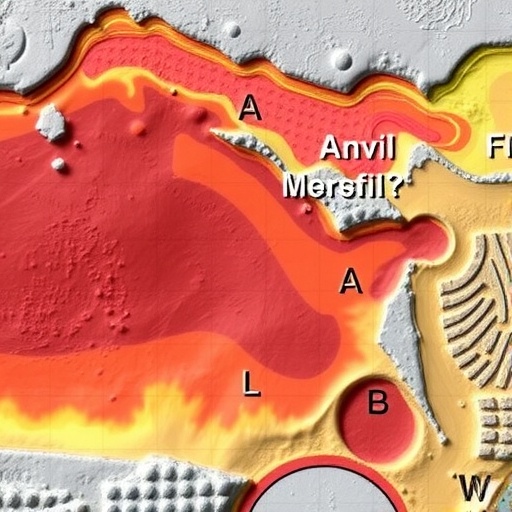Recent research has made significant strides in understanding the complex dynamics of the Earth’s lower mantle. The focus of this empirical study was the behavior of mid-ocean ridge basalt (MORB) and its contribution to seismic velocity anomalies, particularly in relation to the ancient subducted oceanic crust. The findings indicate that traditional theoretical models tend to overestimate the values of G0 and G0′ significantly when compared to actual experimental results. This discrepancy necessitates a closer examination of existing methodologies and mineral phase compositions used in investigations of the Earth’s lower mantle.
One of the key revelations is that theoretical G0 values often lead to a misunderstanding of the mineral dynamics under the extreme conditions present in the lower mantle. This research highlights the necessity of utilizing experimentally derived mineral phases, particularly in evaluating MORB. Traditional estimates have indicated unusually high MORB volume fractions that supposedly need to be present to reconcile observed seismic anomalies of around -1.5%. However, empirical measurements suggest that the contributions required could be significantly lower.
The underpinnings of these findings relate to the peculiarities associated with phase transitions and the inherent partitioning behavior of minerals within the MORB context. Studies that predate this investigation have noted variations in mineral proportions that can substantially influence seismic velocity modeling. As various researchers highlighted the issue of temperature sensitivity in G0′, it becomes clear that any experimental uncertainty can complicate the required mineral volumes necessary to assert these seismic anomalies convincingly.
In evaluating specific mineral compositions, the research revisited how CaSiO3 perovskite (CaPv) interacts with MORB content. It has been proposed that an increase in CaPv content would adjust the necessary SiO2 phase contributions, highlighting the delicate balance in mineralization that influences seismic properties. When analyzing different models of MORB, it appears that even modest adjustments in mineral phase content can yield significant revisions to the overall seismic velocity profile.
This study meticulously incorporated updated constraints on G0 and G0’ values across all bridgmanite endmembers, reinforcing the theoretical framework while paving the way for more accurate representation in seismic modeling. The limitations imposed by the absence of high-temperature experimental data on the diverse mineral phases exacerbate the need for a renewed methodological approach. High-pressure sound velocity data from lower mantle conditions plays a crucial role in resolving previous discrepancies while elucidating the mineral physics associated with the area’s intricate behavior.
As the re-evaluation unveils, the calculated volume fractions required to explain seismic anomalies appear to be lower than previously anticipated. Earlier estimates suggested up to 64% MORB content was necessary, yet findings from this study suggest that just 23-33% may sufficiently account for observed discrepancies in seismic wave velocities. Such revelations could radically alter our approach to interpreting seismic data and understanding the relationship between surface phenomena and deep Earth processes.
The research traverses the nuances of temperature conditions in the lower mantle, emphasizing how variable thermal gradients can dramatically affect calculated shear wave velocities. With modeled scenarios suggesting MORB volume fractions could decrease significantly with temperature increases, the implications are far-reaching. Elevated mantle temperatures, ranging substantially between 2600K to 4000K, directly inform how shear wave velocity contrasts can oscillate, thereby limiting the necessity for higher volume fractions.
Delving deeper into the experimental constraints indicates that any negative shear wave velocity contrast in MORB, although modest, illustrates profound insights into the seismic profiles. Even small variances in estimates can consolidate the understanding of seismic anomalies, emphasizing the importance of empirical data in reshaping theoretical perceptions in geomaterials. While previous studies presented figures revealing high negative shear wave contrasts, the revisions to mean values indicate a need for recalibrating our seismic models with a stronger empirical foundation.
Notably, the research underscores that further understanding of MORB phases and the implementation of refined G0’ values could significantly enhance the theoretical seismic framework, thereby reducing discrepancies in seismic observations. These foundational insights are propelling numerous discussions regarding the complexity of mineral interactions and the resulting effects on our understanding of the lower mantle’s geophysical properties.
As this study delineates the contributions of ancient subducted oceanic crust to observed seismic anomalies, it simultaneously invites a broader inquiry into the implications for geological formation and evolution. The investigation does not merely contemplate the discrepancies but prompts a reevaluation of existing theoretical foundations that have long guided the scientific community. Such a rethinking holds the potential to address long-standing questions regarding the interplay between deep mantle dynamics and surface geological processes, inviting future research to explore these intricate relationships.
In conclusion, this detailed analysis not only recalibrates existing theoretical models regarding the seismic behavior of the lower mantle but also serves as a catalyst for future inquiries into Earth’s geological architecture. By emphasizing the importance of empirical validation and the need for comprehensive studies of mineral phases within the mantle, the research sets a precedent for ongoing discussions around seismic formation phenomena and their broader implications on Earth’s fundamental processes.
Subject of Research: Behavior of mid-ocean ridge basalt (MORB) and its contribution to seismic velocity anomalies in the Earth’s lower mantle.
Article Title: The presence of ancient subducted oceanic crust contributes to seismic anomalies in Large Low Shear Velocity Provinces.
Article References:
Krymarys, E., Murakami, M., Saha, P. et al. The presence of ancient subducted oceanic crust contributes to seismic anomalies in Large Low Shear Velocity Provinces. Commun Earth Environ 6, 713 (2025). https://doi.org/10.1038/s43247-025-02700-8
Image Credits: AI Generated
DOI:
Keywords: Seismic anomalies, mid-ocean ridge basalt, lower mantle, mineral phases, empirical data, geological processes, phase transitions, temperature effects, geophysical properties.




